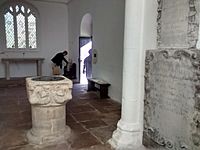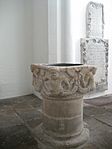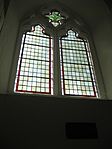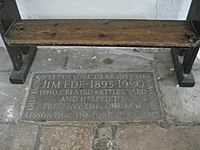St Peter's Church, Cambridge facts for kids
The Church of St Peter is a special old church in Cambridge, England. It's part of the Church of England, which is a Christian church. This church is located on Castle Street, near a place called Kettle's Yard.
Today, St Peter's is looked after by the Churches Conservation Trust. This group helps to save important old churches. The church is usually open for visitors. Sometimes, it even holds art shows with the Kettle's Yard gallery.
Contents
A Look at St Peter's Church History
The Church of St Peter has been known by different names. People used to call it "St Peter by the Castle" or "Beyond the Bridge." This helped tell it apart from another church, Little St Mary's.
How Old is the Church?
The church building you see today is a small part of a much older church. The original church was built way back in the 12th century. That's over 800 years ago! It used to have a main hall (nave), a special area for the altar (chancel), a side aisle, and a tall tower.
Some experts think the church might be even older. It's located across a Roman road from St Giles' Church. This suggests it could have started in the Anglo-Saxon period. But so far, no proof has been found from before the Norman times.
Changes Over the Years
During the time of the Tudor kings and queens, the right to choose the church's priest (called the advowson) went to the Crown. Queen Elizabeth I then gave this right to the Bishop of Ely.
In 1650, local officials found that St Peter's didn't have its own priest's house. They suggested joining its parish with St Giles' Church. For hundreds of years, St Peter's has been connected to St Giles' Church.
What the Church Looks Like Now
St Peter's is now a single-room church. It has a tower at the west end and an eight-sided spire from the 14th century. The spire has small windows called dormers. The church is built from stone rubble, with pebbles used for the tower.
The church was rebuilt to a smaller size in 1781. But you can still see some parts from the Middle Ages. For example, the south doorway is from the 13th century. There's also a baptismal font from the 12th century. This font is decorated with carvings of mermen, who are mythical half-human, half-fish creatures.
By the early 1900s, the church was in bad shape again. It was slowly repaired in the 1930s using concrete and stone.
The Weathervane Story
Look closely at the weathervane on top of the church. It has the letters "AP" on it. People say these letters stand for Andrew Perne. He was an important person at Cambridge University a long time ago. There's a funny story that the letters "AP" could mean different things depending on which way the wind blew. People joked it could mean 'A Papist' (Catholic), 'A Protestant', or 'A Puritan'.
Gallery
-
A stone honoring Jim Ede, who helped save the church and created Kettle's Yard
Images for kids
See also
- All Saints' Church, Cambridge, another church cared for by the Churches Conservation Trust
- Ascension Parish Burial Ground, an old burial ground for this area
- St Giles' Church, Cambridge









